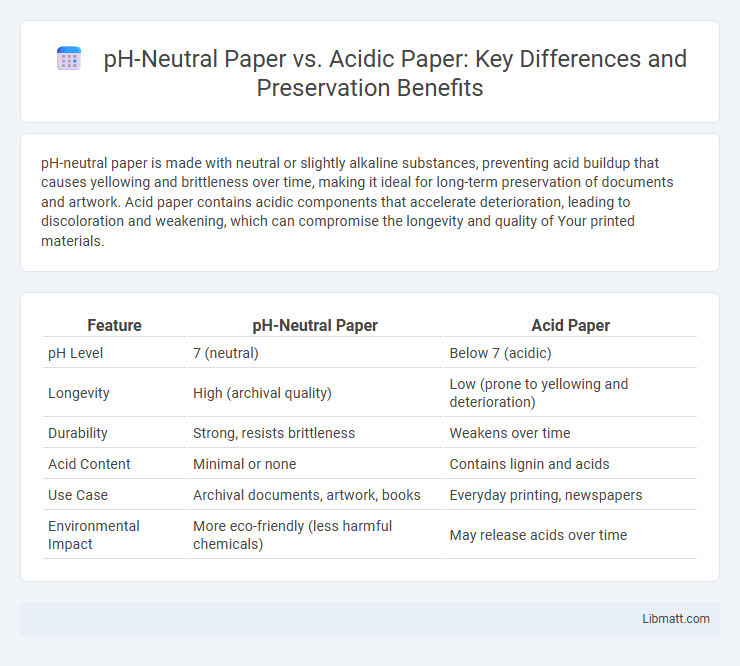pH-neutral paper is made with neutral or slightly alkaline substances, preventing acid buildup that causes yellowing and brittleness over time, making it ideal for long-term preservation of documents and artwork. Acid paper contains acidic components that accelerate deterioration, leading to discoloration and weakening, which can compromise the longevity and quality of Your printed materials.
Table of Comparison
| Feature | pH-Neutral Paper | Acid Paper |
|---|---|---|
| pH Level | 7 (neutral) | Below 7 (acidic) |
| Longevity | High (archival quality) | Low (prone to yellowing and deterioration) |
| Durability | Strong, resists brittleness | Weakens over time |
| Acid Content | Minimal or none | Contains lignin and acids |
| Use Case | Archival documents, artwork, books | Everyday printing, newspapers |
| Environmental Impact | More eco-friendly (less harmful chemicals) | May release acids over time |
Introduction to Paper Acidity
pH-neutral paper maintains a balanced pH level of around 7, making it resistant to yellowing and deterioration over time. Acid paper, with a lower pH below 7, contains acidic compounds that cause it to become brittle and discolored, compromising document longevity. Choosing pH-neutral paper ensures your important records and artworks remain preserved and stable for decades.
What is pH-Neutral Paper?
pH-neutral paper is manufactured using a chemical process that ensures the paper has a balanced pH level of around 7, making it neither acidic nor alkaline. Unlike acid paper, which contains acidic components that can cause yellowing and deterioration over time, pH-neutral paper provides superior longevity and durability for documents and artwork. Your choice of pH-neutral paper helps preserve important records by preventing the brittleness and discoloration associated with acidic materials.
Characteristics of Acidic Paper
Acidic paper, typically made from wood pulp containing lignin, tends to yellow, become brittle, and deteriorate over time due to its low pH level, usually below 7. This type of paper is prone to chemical degradation, causing significant damage to important documents, photographs, and books if not stored properly. You should choose pH-neutral paper for better longevity and archival quality, as it resists aging and maintains its structural integrity much longer than acidic paper.
Manufacturing Processes Compared
pH-neutral paper is produced using alkaline sizing agents, such as calcium carbonate, which improves its durability and resistance to yellowing over time, making it ideal for archival purposes. Acid paper manufacturing involves acid-based sizing, often alum-rosin, resulting in shorter lifespan due to lignin and acid-induced degradation. The alkaline process in pH-neutral paper also reduces environmental impact by minimizing harmful acidic byproducts during and after production.
Durability and Longevity
pH-neutral paper is designed to resist yellowing and deterioration over time, ensuring superior durability and longevity compared to acid paper, which tends to become brittle and discolored due to acid content. Your documents printed on pH-neutral paper maintain clarity and strength for decades, making it ideal for archival purposes. Acid paper's poor longevity causes it to degrade rapidly, limiting its use for preserving important records or artworks.
Environmental Impact
pH-neutral paper significantly reduces environmental harm due to its longevity and biodegradability, minimizing the need for frequent replacements and decreasing waste accumulation. Acid paper deteriorates rapidly, contributing to increased deforestation and landfill use as documents must be regularly reprinted or preserved with chemical treatments. Choosing pH-neutral paper supports sustainable forestry practices and lessens your environmental footprint through enhanced recyclability and reduced chemical pollution.
Common Uses of pH-Neutral vs Acid Paper
pH-neutral paper is commonly used for archival purposes, art prints, and important documents due to its durability and resistance to yellowing over time. Acid paper, often found in newspapers and inexpensive books, is prone to deterioration and brittleness, making it less suitable for long-term preservation. Choosing pH-neutral paper helps ensure your printed materials maintain their quality and longevity.
Preservation and Archival Standards
pH-neutral paper, often classified as acid-free, offers superior preservation qualities by resisting yellowing and brittleness over time, making it ideal for archival standards. Acidic paper contains lignin and low pH levels that accelerate degradation, compromising long-term document integrity. Institutions and conservators prioritize pH-neutral paper to meet rigorous archival standards that ensure the longevity of important records and historical documents.
Cost and Availability
pH-neutral paper generally costs more due to its higher-quality production processes and the use of alkaline fillers, which increase longevity and durability. Acid paper is more widely available and less expensive, primarily because it uses cheaper acidic materials that degrade faster over time. Libraries and archives often prefer pH-neutral paper despite the higher cost, prioritizing preservation over immediate affordability.
Choosing the Right Paper for Your Needs
Selecting pH-neutral paper is essential for archival purposes as it prevents yellowing and deterioration over time, making it ideal for documents requiring long-term preservation. Acid paper, while often less expensive, tends to degrade faster due to its acidic content, leading to brittleness and discoloration. Understanding the pH level and intended use helps determine the best paper choice for durability and quality in printing or writing projects.
pH-neutral paper vs acid paper Infographic

 libmatt.com
libmatt.com